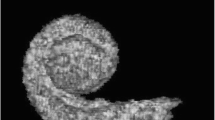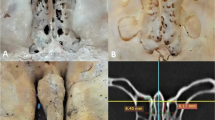Abstract
Various studies have shown variations in size and shape of different anthropometric measurements of external auditory canal. We conducted an anthropometric study of the three-dimensional anatomy of the osseous external auditory canal (OEAC) using high-resolution computed tomography the temporal bone to identify the variations in subset of Indian population from North India. A retrospective review of high-resolution computed tomography images of the temporal bones of 125 patients (250 external auditory canals) of different ages (mean 28.43 years) acquired from September 2014 to February of 2015 was performed. Using a method, as proposed by Mahboubio et al. (Otol Neurotol 33:715–720, 2012), six defined dimensions of the OEAC in the parasagittal planes were recorded at the level of annulus, midcanal and the outermost point of osseous external auditory canal at bony-cartilaginous junction. The length and shape of the OEAC were also studied and the frequency rate of each was recorded. The most prevalent shape of the OEAC was found to be conical (64%) and the mean osseous external auditory canal length was 9.61 mm. The length of the OEAC was significantly different between ages above and below 12 years while the 6 defined cross sectional dimensions were statistically significant between ages above and below 8 years. The history of chronic suppurative otitis media had a significant bearing on the inferior mid-anteroposterior dimension at the level of bony-cartilaginous junction. There was statistically significant difference in supero-inferior diameter in the posterior half at the level of mid-canal and outer bony-cartilaginous junction between males and females. The comprehensive set of standardized measurements collected in this study provides three-dimensional information on osseous external auditory canal geometry. These measurements and the methodology will contribute to the development of element models of the osseous canal for computational modeling purposes and also provide important measurements for design of in-the-canal hearing aids, specialized earplugs and for defining average sizes for canalplasty procedures, in pre- and postoperative surgical planning and assessment of canal atresia and stenosis in Indian population. No such previous study has been done in North Indian population.



Similar content being viewed by others
References
Mahboubi H, Wu EC, Jahanbakhshi R, Coale K, Rothholtz VS, Zardouz S, Djalilian HR (2012) A novel method to determine standardized anatomic dimensions of the osseous external auditory canal. Otol Neurotol 33:715–720
Oliveira RJ (1997) The active ear canal. J Am Acad Audiol 8:401–410
Ekinci G, Koc A, Baltacioglu F, Veyseller B, Altintas O, Han T (2004) Temporal bone measurements on high-resolution computed tomography. J Otolaryngol 33:387–389
Virapongse C, Sarwar M, Sasaki C, Kier EL (1983) High resolution computed tomography of the osseous external auditory canal: 1. Normal anatomy. J Comput Assist Tomogr 7:486–492
Liu B et al (2008) Incorporating anthropometry into design of ear-related products. Appl Ergonom 39:115–121
Kimberley BP, Fromovich O (1999) Flexible approach to tympanomastoidectomy. Otolaryngol Clin North Am 32:585–595
Eckerdal O, Ahlqvist J, Alehagen U, Wing K (1978) Length dimensions and morphologic variations of the external bony auditory canal. A radiographic and histologic investigation. Dentomaxillofac Radiol 7:43–50
Eckerdal O, Ahlqvist J (1980) External bony auditory canal and the tympanic bone. Morphologic properties and influences on the tomographic reproduction. Acta Radiol Diagn (Stockh) 21:425–431
Smelt G, Hawke M, Proops D (1988) Anatomy of the external ear canal: a new technique for making impressions. J Otolaryngol 17:249–253
Egolf DP, Nelson DK, Howell HC (1993) Quantifying ear-canal geometry with computer-assisted tomographic scans. J Acoust Soc Am 93:2809–2819
Tu TH, Yu JF, Wang RH et al (2014) Anthropometry of external auditory canal by non-contactable measurement. Internoise 50:50–55
Shanks JE, Lilly DJ (1981) An evaluation of tympanometric estimates of ear canal volume. J Speech Hear Res 24:556–561
Shahnaz NaDD (2006) Standard and multifrequency tympanometric norms for Caucasians and Chinese young adults. Ear Hear 27:75–90
Zemplenyi J, Gilman S, Dirks D (1985) Optical methods for measurement of ear canal length. J Acoust Soc Am 78:2146–2148
Tognola G, Parazzini M, Svelto C, Galli M, Ravazzani P, Grandori F (2004) Design of hearing aid shells by three dimensional laser scanning and mesh reconstruction. J Biomed Opt 9:835–843
Unal G, Nain D, Slabaugh G, Fang T (2008) Customized design of hearing aids using statistical shape learning. Med Image Comput Assist Interv 11:518–526
Author information
Authors and Affiliations
Corresponding author
Rights and permissions
About this article
Cite this article
Singh, P., Mittal, M.K., Mathur, N.N. et al. Morphometric Analysis of the External Auditory Canal by Computed Tomography in Indian Population. Indian J Otolaryngol Head Neck Surg 71 (Suppl 2), 1115–1122 (2019). https://doi.org/10.1007/s12070-017-1200-8
Received:
Accepted:
Published:
Issue Date:
DOI: https://doi.org/10.1007/s12070-017-1200-8




